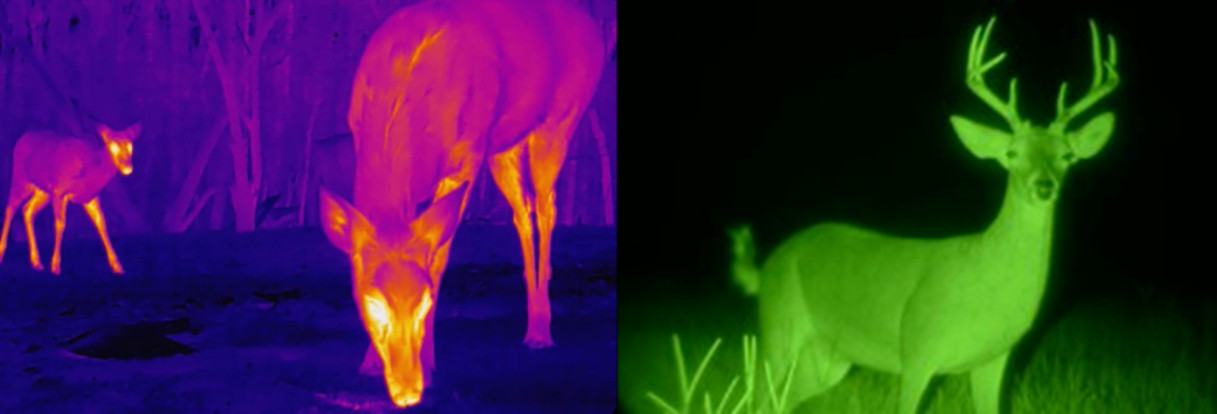What Is the Difference Between Thermal Imaging and Infrared Imaging?

Thermal imaging and infrared (IR) are two distinct technologies used to detect and measure thermal energy. Although they are often used interchangeably, there are some key differences between the two.
Thermography is a technique that uses infrared radiation to create an image of an object based on its temperature. It is a non-contact, non-destructive method of temperature measurement that can be used to detect heat signatures over long distances. Thermal imaging cameras use special lenses to focus infrared radiation onto a detector array, which then converts the radiation into electrical signals. The signal is then processed to create an image showing the temperature distribution of the object being measured.
Infrared, on the other hand, refers to the part of the electromagnetic spectrum that lies between visible light and radio waves. All objects with a temperature above absolute zero emit infrared radiation and can be detected with specialized equipment such as thermal imaging cameras or infrared thermometers. Infrared thermometers measure the temperature of an object by detecting the amount of infrared radiation emitted by the object.
The main difference between thermal imaging and infrared is that thermal imaging creates images based on temperature differences, while infrared direct measures temperature. Thermal imaging can be used to detect temperature changes over large areas or to identify hot spots in mechanical or electrical systems. Infrared thermometers are more accurate and can be used to measure the temperature of a specific point on an object.
Another difference between thermal imaging and infrared is their application. Thermal imaging is commonly used in areas such as building inspections, electrical maintenance, agriculture, and fire protection. Infrared light is used in a wide range of applications including medical imaging, food processing, and scientific research.
To sum up, both thermal imaging and infrared are technologies used to detect and measure thermal energy, but the measurement methods and applications differ.
Thermal Imaging and Infrared Night Vision
Thermal imaging and infrared night vision are two different technologies used for different purposes. Thermal imaging detects infrared radiation emitted by objects and converts it into a visible image, while infrared night vision amplifies available light in the environment to produce a visible image. In this section, we will explore the differences between thermal imaging and infrared night vision and the applications of each.
Thermography, also known as infrared thermography or thermal video, is a technique that detects the heat signature of an object and converts it into an image. The technology is based on the principle that all objects emit infrared radiation, which can be detected using a thermal imaging camera. Thermal imaging is commonly used in industrial, military and medical applications.
One of the main advantages of thermal imaging is its ability to detect temperature differences. This makes it useful for detecting mechanical anomalies, identifying hot spots in electrical systems, and locating leaks in buildings. Thermal imaging is also used in firefighting to locate hot spots and identify hot areas.
Another advantage of thermal imaging is its ability to see through smoke, fog, and other obstructions. This makes it useful for search and rescue operations, as well as military applications such as surveillance and targeting.
Infrared Night Vision:
Infrared night vision, also known as image enhancement or low-light imaging, is a technology that amplifies the light available in the environment to produce a visible image. The technology is based on the principle that photons can be converted into electrons using a photocathode. The resulting electrons are then amplified using an electron multiplier and converted back into photons using a phosphor screen.
Infrared night vision is commonly used in military, law enforcement, and hunting applications. It allows users to see in low-light conditions without the need for additional light sources. Infrared night vision can also be combined with other technologies such as thermal imaging to provide enhanced situational awareness. Also, it can be used to find hidden cameras in public places like hotels and toilets, or even your home.
One of the main disadvantages of infrared night vision is its limited range. It depends on the amount of light available in the environment, which may be affected by weather conditions and other factors. Infrared night vision is also susceptible to glare and halos from bright light sources.
The above introduces the difference between thermal imaging and infrared imaging. If you want to buy a thermal imager or infrared camera, please contact us.
With excellent production technology and considerate service, JAVOL has become one of the leading infrared thermal imaging systems manufacturers. Our professional production team and complete management system can meet the diverse needs of customers. We will continue to adjust and optimize new solutions according to customer needs, and provide customers with thoughtful one-stop service.
